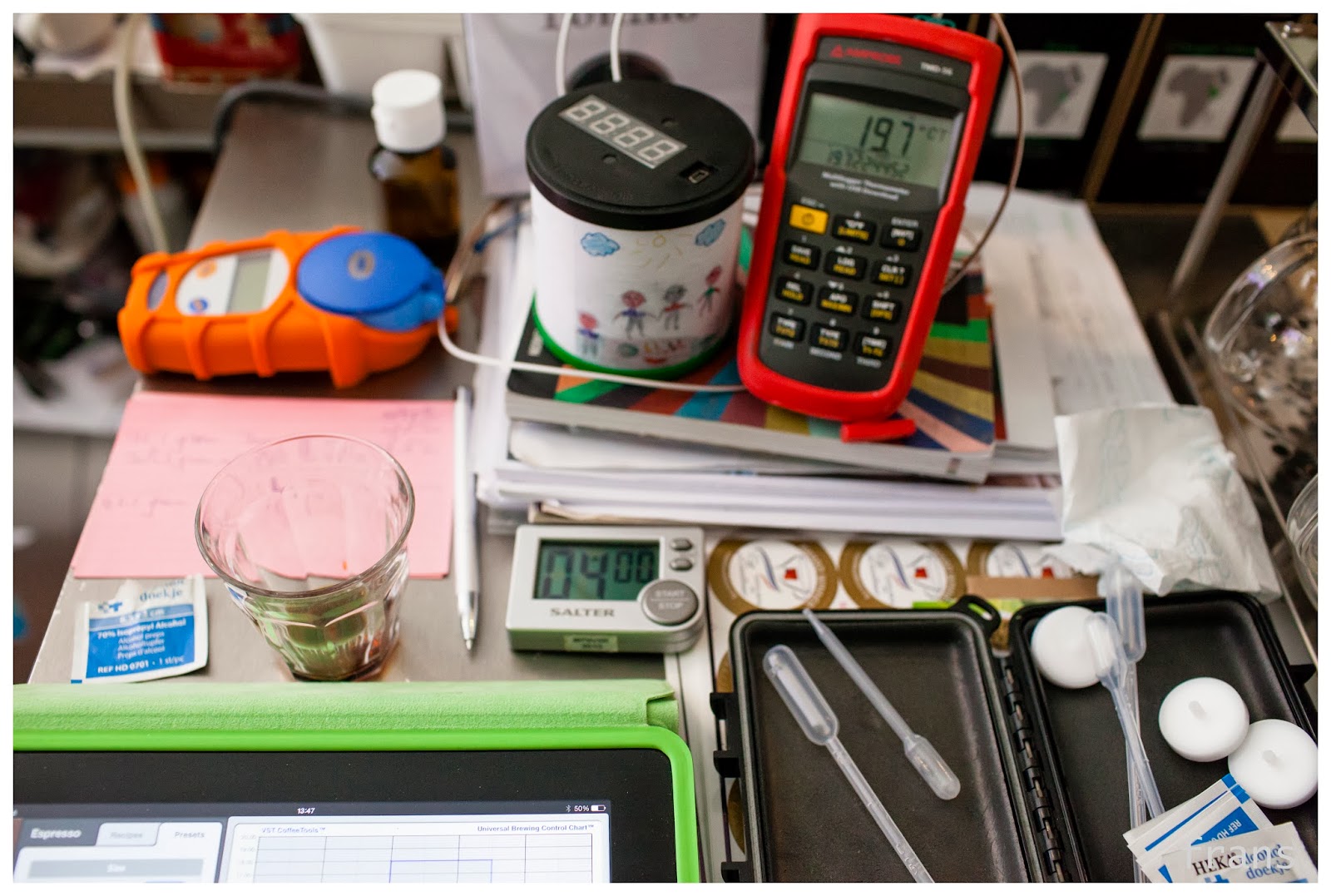VST Labs Coffee Refractometer & App
How much of the coffee you ground has been sucked up by hot water and
arrived in your cup to taste? Is it the considered optimum of 20%? You
can bake your puck and weigh it later to guess, but you could measure it
too and use a coffee cockpit of slides and gauges to navigate your next
cup.
Here's a video by Matt Perger:
At the Coffee Company they also use a VST refractometer and the App from VST Labs to measure this: (below is a snapshot from https://vimeo.com/84681146 )
We got one from the VST labs and did some first measurements. Turns out a cup we like, made with 15g of ground coffee beans, extracted 25g in 40 seconds on the lever machine, gave 8.8% TDS which is a bit low. Within the targeted Coffee Brew Formula but too weak on the given chart.
There's more to try with grind setting and dose to define the optimal mix of variables!
Here's a video by Matt Perger:
At the Coffee Company they also use a VST refractometer and the App from VST Labs to measure this: (below is a snapshot from https://vimeo.com/84681146 )
We got one from the VST labs and did some first measurements. Turns out a cup we like, made with 15g of ground coffee beans, extracted 25g in 40 seconds on the lever machine, gave 8.8% TDS which is a bit low. Within the targeted Coffee Brew Formula but too weak on the given chart.
There's more to try with grind setting and dose to define the optimal mix of variables!
 |
| Espresso cooling |
 |
| Filtered (right) through filter head on syringe (left) |
 |
| Drops on the eye of the TDS, below the blue lid |
 | |
| Measures 8.8% TDS, a bit low on the green line in the Brewing Contro Chart on the iPad app
On the Home-Barista forum, I received some good advice from several different members:
Dick Green wrote:
Bryan Truitt wrote:
I like the idea of taking the freedom to vary and experiment, taste and then also measure the outcome.
On his blog Matt Perger posts a number of recipes on the espresso machine that vary wildly in TDS and extraction value. Some coffee is much more like filter coffee than typical espresso: "Espresso Course –(He served these during the 2013 Championships: http://www.youtube.com/watch?v=ZgKgt2gtzD0)
---
Next I pulled & measured an Ethiopia Amaro Gayo that I find delicious in the cup, despite some
passing sense of dryness. A pleasant mix of tastes that I find hard to
describe so I won't delve deep to try it.
About one percent lower extraction-% and %TDS.
Next, I tried the delicious Panama, Los Lajones beans on the Mahlkönig Vario grinder and the Rocket E61 machine, using 20g in the 20g-VST basket to brew 31.3g of espresso. This machine has a dual OPV so I could ramp up the pre-infusion at 4 bar, first drops appearing at 6 seconds, then up to 9 bar for 6 seconds and extracting the rest at 4 bar again. A delightful, somewhat 'salty' taste:  Another photo impression of a measurement session:
Extraction:
Setup, with the Tonino that I use to measure the color of the grinds before the extraction:
Half of the espresso to taste and half of it in a big cool cup to cool down
Filtered espresso in the small heavy shot glass, taken out with pipette, drops on the refractometer:

Measurement done, ready to copy into the app
At Trakteren, a local coffee specialty place, I was invited to demo the setup and we did two measurements:
At home, I tried several extractions with Ethiopian "Cherry Red" beans that I roasted three weeks ago. At 16-17 % extractions these taste rich and spicy, like Dutch "speculaas" dipped in coffee, almond candy, and at slightly lower extractions it's a soft, light espresso. Both very enjoyable even though all of these were at lower extractions than the "box" of the app would have you expect.
|

















Reacties